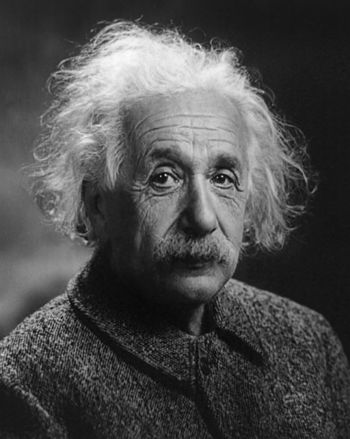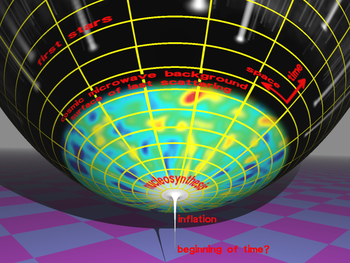 |
| English: Albert Einstein (Photo credit: Wikipedia) |
Arguably the greatest genius of all-time, Albert Einstein, made some colossal mistakes that it took others to correct. Here are the four biggest.
Einstein made numerous mistakes in his derivations, although his most famous results turned out to be quite robust. Image credit: Einstein deriving special relativity, 1934.
1.) Einstein erred in his 'proof' of his most famous equation, E = mc^2. In 1905, his "miracle year," Einstein published papers about the photoelectric effect, Brownian motion, special relativity and mass-energy equivalence, among others. A number of people had worked on the idea of a "rest energy" associated with massive objects, but couldn't work out the numbers. Many had proposed E = Nmc^2, where N was a number like 4/3, 1, 3/8 or some other figure, but nobody had proved which one was correct. Until Einstein did it, in 1905.
At least, that's the legend. The truth might deflate your view of Einstein a bit, but here it is: Einstein was only able to derive E = mc^2 for a particle completely at rest. Despite also inventing special relativity -- founded on the principle that the laws of physics are independent of an observer's frame of reference -- Einstein's formulation couldn't account for how energy worked for a particle in motion. In other words, E = mc^2 as derived by Einstein was frame-dependent! It wasn't until Max von Laue made the critical advance, six years later, that showed the flaw in Einstein's work: one must get rid of the idea of kinetic energy. Instead, we now talk about total relativistic energy, where the traditional kinetic energy -- KE = ½mv^2 -- can only emerge in the non-relativistic limit. Einstein made similar errors in all seven of his derivations of E = mc^2, spanning his entire life, despite that in addition to von Laue, Joseph Larmor, Wolfgang Pauli and Philipp Lenard all successfully derived the mass/energy relationship without Einstein's flaw.
No One, Not Even Newton Or Einstein, Was The Muhammad Ali Of Physics
2.) Einstein added a cosmological constant, Λ, in General Relativity to keep the Universe static. General Relativity is a beautiful, elegant and powerful theory that changed our conception of the Universe. Instead of a Universe where gravitation is the instantaneous, attractive force between two masses located at fixed positions in space, the presence of matter and energy -- in all its forms -- affects and determines the curvature of spacetime. The density and pressure of the full sum of all forms of energy in the Universe play a role, from particles to radiation to dark matter to field energy. But this relationship was no good to Einstein, so he changed it. Dark energy is said to account for more than two-thirds of the total energy of the visible universe. But so far, trying to prove what dark energy is made up of has been impossible
You see, what Einstein had determined was that a Universe full of matter and radiation was unstable! It would have to be either expanding or contracting if it were filled with massive particles, which our Universe clearly is. So his "fix" for this was to insert an extra term -- a positive cosmological constant -- to exactly balance the attempted contraction of the Universe. This "fix" was unstable anyway, as a slightly denser region than normal would collapse anyway, while a slightly less dense than average region would expand away forever. If Einstein had been able to resist this temptation, he could have predicted the expanding Universe before Friedmann and Lemaître did, and before Hubble uncovered the evidence that proved it. Although we do actually appear to have a cosmological constant in our Universe (responsible for what we call dark energy), Einstein's motivations for putting it in were all wrong, and prevented us from predicting the expanding Universe. It really was a great blunder on his part.
3.) Einstein rejected the indeterminate, quantum nature of the Universe. This one is still controversial, likely primarily due to Einstein's stubbornness on the subject. In classical physics, like Newtonian gravity, Maxwell's electromagnetism and even General Relativity, the theories really are deterministic. If you tell me the initial positions and momenta of all the particles in the Universe, I can -- with enough computational power -- tell you how every one of them will evolve, move, and where they will be located at any point in time. But in quantum mechanics, there are not only quantities that can't be known in advance, there is a fundamental indeterminism inherent to the theory.
The wave pattern for electrons passing through a double slit. If you measure "which slit" the electron goes through, you destroy the quantum interference pattern shown here. Image credit: Dr. Tonomura and Belsazar of Wikimedia Commons, under c.c.a.-s.a.-3.0.
The wave pattern for electrons passing through a double slit. If you measure "which slit" the electron goes through, you destroy the quantum interference pattern shown here. Image credit: Dr. Tonomura and Belsazar of Wikimedia Commons, under c.c.a.-s.a.-3.0.
The better you measure and know the position of a particle, the less well-known its momentum is. The shorter a particle's lifetime, the more inherently uncertain its rest energy (i.e., its mass) is. And if you measure its spin in one direction (x, y, or z), you inherently destroy information about it in the other two. But rather than accept these self-evident facts and try and reinterpret how we fundamentally view the quanta making up our Universe, Einstein insisted on viewing them in a deterministic sense, claiming that there must be hidden variables afoot. It's arguable that the reason physicists still bicker over preferred "interpretations" of quantum mechanics is rooted in Einstein's ill-motivated thinking, rather than simply changing our preconceptions of what a quantum of energy actually is. SMBC has a good comic illustrating this.
4.) Einstein held onto his wrongheaded approach to unification until his death, despite the overwhelming evidence that it was futile. Unification in science is an idea that goes back well before Einstein. The idea that all of nature could be explained by as few simple rules or parameters as possible speaks to the power of a theory, and simplicity is as strong an allure as science ever had. Coulomb's law, Gauss' law, Faraday's law and permanent magnets can all be explained in a single framework: Maxwell's electromagnetism. The motion of terrestrial and heavenly bodies was first explained by Newton's gravitation and then even better by Einstein's General Relativity. But Einstein wanted to go even farther, and attempted to unify gravitation and electromagnetism. In the 1920s, much headway was made, and Einstein would pursue this for the next 30 years.
But experiments had revealed some significant new rules, which Einstein summarily ignored in his stubborn pursuit to unify these two forces. The weak and strong nuclear forces obeyed similar quantum rules to electromagnetism, and the application of group theory to these quantum forces led to the unification we know in the Standard Model. Yet Einstein never pursued these paths or even attempted to incorporate the nuclear forces; he remained stuck on gravity and electromagnetism, even as clear relationships were emerging between the others. The evidence was not enough to cause Einstein to change his path. Today, the electroweak force picture has been confirmed, with Grand Unification Theories (GUTs) theoretically adding the strong force to the works, and string theory finally, at the highest energy scales, as the leading candidate for bringing gravity into the fold. As Oppenheimer said of Einstein,
During all the end of his life, Einstein did no good. He turned his back on experiments... to realise the unity of knowledge.
Even geniuses get it wrong more often than not. It would serve us all well to remember that making mistakes is okay; it's failing to learn from them that should shame us.















